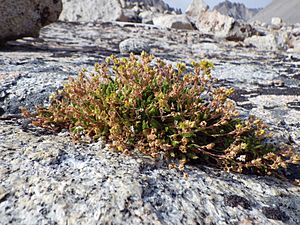Clubmoss mousetail facts for kids
Quick facts for kids Clubmoss mousetail |
|
|---|---|
 |
|
| Scientific classification | |
| Genus: |
Ivesia
|
| Species: |
lycopodioides
|
Ivesia lycopodioides, often called clubmoss mousetail or clubmoss ivesia, is a unique flowering plant. It belongs to the rose family, which includes many plants you might know, like roses, apples, and strawberries! This special plant is found in the beautiful Sierra Nevada mountains, mainly in California, and sometimes it grows across the border into Nevada.
This plant is a perennial herb. This means it lives for more than two years, coming back to life each spring. You can often spot it growing in tiny cracks in mountain rocks or in wet, grassy areas high up in the mountains.
What Does Clubmoss Mousetail Look Like?
Clubmoss mousetail is quite small but interesting. It grows a cluster of leaves at its base, called a rosette. These leaves can be up to 15 centimeters (about 6 inches) long. Each leaf is made up of many tiny, lobed leaflets, which gives them a unique look.
From this rosette, stems grow up to 30 centimeters (about 12 inches) long. These stems can either stand straight up or droop down. Each stem holds a cluster of bright yellow flowers.
Its Flowers Up Close
The flowers of the clubmoss mousetail are very pretty. Each flower has:
- Hairy, greenish, triangular parts called sepals. These are like small leaves that protect the flower bud.
- Much larger, oval-shaped petals that are a bright, sunny yellow. These are the showy parts that attract pollinators.
- Usually five stamens in the center. Stamens are the male parts of the flower that produce pollen.
- Several pistils. Pistils are the female parts of the flower where seeds develop.
There are three slightly different types, or subspecies, of clubmoss mousetail. Each one might have small variations in its appearance or where it grows.
Where Does Clubmoss Mousetail Grow?
This plant is native to the Sierra Nevada mountain range. This range stretches along the eastern side of California and into parts of Nevada. The Sierra Nevada is known for its tall peaks, deep valleys, and diverse plant life.
Clubmoss mousetail prefers specific places to grow:
- Rock crevices: It often finds a home in the small cracks and ledges of rocks in the mountains.
- Wet meadows: You can also find it in high-elevation meadows that stay wet, often from melting snow.
These specific habitats help the plant thrive in the sometimes harsh mountain environment.

